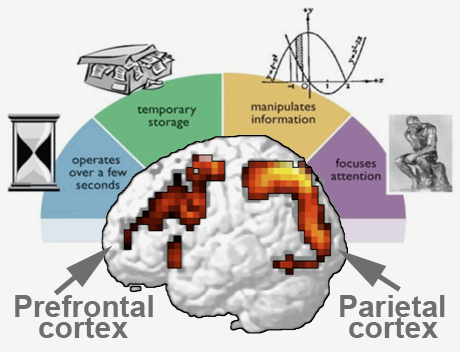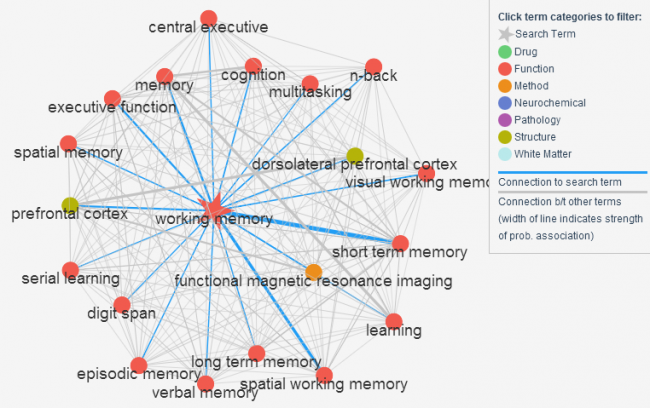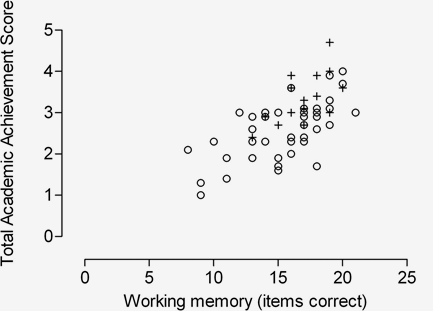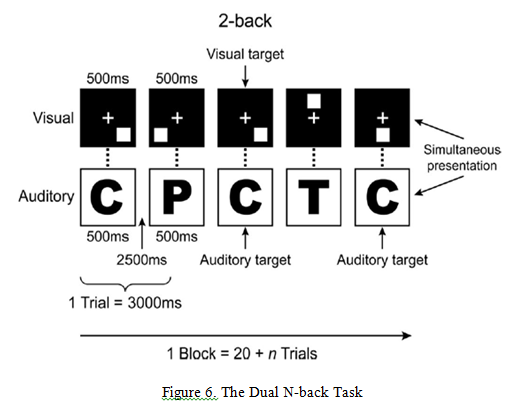HighIQPro has been designed to expand working memory capacity. In this article I will look at the scientific basis of the connecting threads between working memory, working memory capacity, working memory training and IQ. I will be answering the question: How does working memory training increase IQ?
Working Memory Definitions
Working memory has been has been defined in everyday language as:
“a set of skills that helps us keep information in mind while using that information to complete a task or execute a challenge.”
And:
“a brain system that provides temporary storage and manipulation of the information necessary for such complex cognitive tasks as language comprehension, learning, and reasoning.”
Working memory is our general purpose mental workspace. It is, more technically:
“a flexible, capacity limited, mental workspace used to store and process information in the service of on-going cognition.”
Morrison & Chein, 2010
.
.
Working memory is the core brain function critical for all higher order cognition – not just intelligence and problem solving, but also decision making, planning, comprehension, and critical thinking.
Brain basis of working memory
Working memory involves both the pre-frontal cortex and parietal cortex – in the so-called ‘fronto-parietal axis’ as shown here (working memory functions are shown above).
.
Working memory can be considered as the main control centre or ‘hub’ of widespread brain functions, as illustrated in this BrainScanr graph:
Working memory capacity definition
Working memory capacity reflects the ability to maintain a few task-relevant items of information (such as concepts, rules or images) in the face of distracting irrelevant information. Since working memory makes information available for more advanced cognitive processing, working memory capacity – the number of distinct ‘chunks’ of information you can hold in mind at the same time – is one of the main rate limiting factors for higher-order cognitive functions.
In general terms, the larger your working memory capacity or ‘mental workspace’, the greater your capacity for higher order cognition and thus academic and professional achievement.
An example of this relationship is shown in the scatter plot graph. Here academic achievement is predicted by working memory capacity.
.
Individuals differ in the size of their working memory capacity, and because of this, they differ in their capacity to reason, make decisions, plan and comprehend. There is also a normal decline in working memory capacity with aging, starting around 25-30 years of age, with a decline of about 5-10% per decade.
Working memory and intelligence
Fluid intelligence is involved in reasoning and when complex relationships have to be perceived and used to find solutions for new problems (Gray, Chabris & Braver, 2003).
Fluid intelligence is at the core of general intelligence which has been defined by researchers in the field as:
A very general mental capability that, among other things, involves the ability to reason, plan, solve problems, think abstractly, comprehend complex ideas, learn quickly and learn from experience. It is not merely book learning, a narrow academic skill, or test-taking smarts. Rather, it reflects a broader and deeper capability for comprehending our surroundings—”catching on,” “making sense” of things, or “figuring out” what to do.
Gottfredson, 1997
It is clear from the definition how intelligence and working memory are closely related mechanisms.
Using a latent variable approach (controlling for the specific variance related to the particular task demands or materials), Kane and colleagues showed that the correlation between working memory capacity and fluid intelligence was +.72. That’s a big correlation!
In addition to this close link, there are closely overlapping brain areas: the prefrontal cortex & parietal cortex.
What explains the link between intelligence (IQ) and working memory?
No one knows the precise mechanism. Gray and colleagues (2003) argue that differences in fluid intelligence (and thus IQ scores) are due to differences in attentional control, particularly in the ability of our attention to filter out distractors – information that might attract your attention but which is irrelevant to the task at hand.
Dual n-back training exercises that do not build in the ability to practice with distractors are not likely to increase intelligence.
Effective working memory training: HighIQPro dual N-back training
The aim of all working memory training programs is to expand working memory capacity. The most widely studied brain training exercise targeting working memory capacity is the N-back task, and HighIQPro implements an scientifically effective version of this.
“The results of individual studies encourage optimism regarding the value of working memory training as a tool for general cognitive enhancement. …Studies of core training show improvements in a variety of areas of cognition (e.g. cognitive control, reading comprehension), persist even with the use of tightly matched controls, and are consistent with neuroimaging studies demonstrating activation changes in regions associated with domain-general cognitive performance. Core WM training thus represents a favourable approach to achieve broad cognitive enhancement”
“there is a rapidly growing number of studies demonstrating that training-related increases in working memory capacity can yield improvements in a range of important cognitive skills (Chein & Morrison, 2010) as well as improved cognitive function in clinical populations with known working memory deficiencies.”
Morrison & Chein, 2011
Brain training with HighIQPro can effectively expand the central workspace of the mind, and by doing so improve intelligence, increase IQ (the measure of intelligence), and improve a wide range of higher cognitive abilities.
References
Gray, J. R., Chabris, C. F., & Braver, T. S. (2003). Neural mechanisms of general fluid intelligence. Nat Neurosci, 6(3), 316–322. doi:10.1038/nn1014
Gottfredson, L.S. (1997). “Foreword to “intelligence and social policy”” (pdf). Intelligence 24 (1): 1–12.doi:10.1016/S0160-2896(97)90010-6.
Kane, M. J., Hambrick, D. Z., Tuholski, S. W., Wilhelm, O., Payne, T. W., & Engle, R. W. (2004). The Generality of Working Memory Capacity: A Latent-Variable Approach to Verbal and Visuospatial Memory Span and Reasoning. Journal of Experimental Psychology: General, 133(2), 189–217. doi:10.1037/0096-3445.133.2.189
Morrison, A. B., & Chein, J. M. (2011). Does working memory training work? The promise and challenges of enhancing cognition by training working memory. Psychonomic Bulletin & Review, 18(1), 46–60. doi:10.3758/s13423-010-0034-0








I strongly believe that Yoga and chakra meditation is so much effective in our body fitness, mental and also for spiritual energy and helps to improve intelligence.